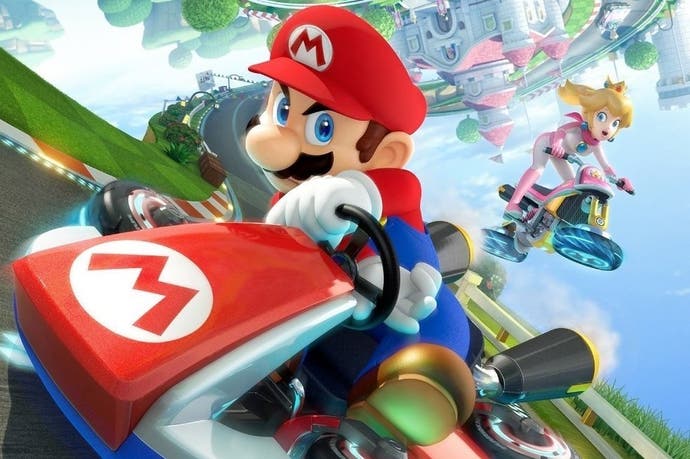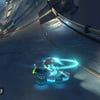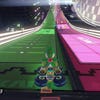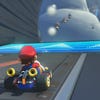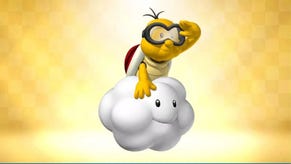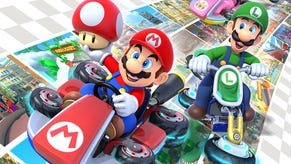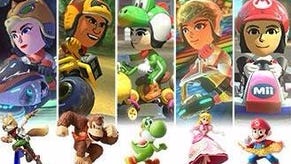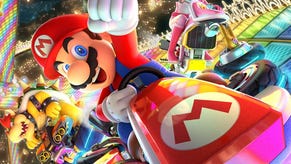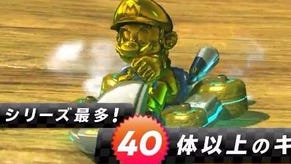Digital Foundry vs Mario Kart 8
Mario & All-Stars Racing Refined.
If there's one Nintendo franchise that can be counted on to deliver the goods time and again, it's Mario Kart. As perhaps the most iterative of its hallowed franchises, each new instalment further refines the formula in ways typically reserved for competitive fighting games. In this regard Mario Kart 8 is no exception and presents, in many ways, the most radical departure the series has seen in more than a decade. Tracks now twist and turn about in a gravity-defying WipEout/F-Zero manner while visual complexity is on a whole new level compared to previous offerings. But has Nintendo retained that oh-so-perfect balance between sharp, colourful visuals and a smooth, consistent frame-rate? Failing to nail down this aspect of the game could seriously hurt the experience and tarnish a near-perfect track record.
That's not something we were worried about, of course. This is Nintendo, after all, which have become well-known for its ability to produce digital gold that surpasses the hardware limitations of the host platform. Last year we heaped praise upon Super Mario 3D World for delivering one of the most polished experiences in console gaming, and we expected to find the same thing here with Mario Kart 8. To a degree, this is true, but in looking closer at the game we've uncovered some unexpected surprises. While it's a beautiful game with phenomenal attention to detail, it's also one that doesn't quite match the impossibly high level of polish we've come to expect from Nintendo on Wii U.
Starting from the top, then, there has been a surprising amount of confusion surrounding the resolution of the game with some sources even suggesting a native 1080p presentation. We can finally put that rumour to rest right here and confirm that Mario Kart 8 instead operates at what is effectively the console's standard 1280x720. Of course, considering the quality of the visuals, this can hardly be considered a disappointment especially when other developers are struggling to hit 1080p consistently on more powerful hardware. What is surprising, however, is the complete omission of anti-aliasing in any form. At the very least, Nintendo has previously utilised a basic edge-smoothing algorithm across its Wii U titles and such a feature could have demonstrably improved image quality without a serious performance hit. As it stands, however, we're left with a heavily aliased presentation filled with obvious stair-stepping and pixel-crawling artefacts throughout most scenes. Busier areas can even result in a loss of detail to the point of reducing visibility.
Thankfully, the lacklustre image quality does little to spoil an otherwise magnificent visual package. It's immediately apparent that a lot of effort is invested in creating rich, vibrant courses loaded with peripheral detail. Tracks are alive and bursting with colour and animation backed by an overhauled lighting solution and a smattering of excellent texture-work. The addition of gravity-defying magnetic sections has also allowed the designers to go a bit crazy with track design, giving way to massive moving structures and detailed metallic obelisks rising sharply out of the terrain.
"Mario Kart 8 effectively operates at 59fps with a subtle but continuous stutter visible on-screen."
This is all enhanced by a convincing combination of real-time and pre-baked shadows that even take occluded edges into account. Complimenting this is a vast array of dynamic light sources, such as headlights, item boxes, and special effects, made possible by what we suspect is a shift to a deferred rendering solution. Even in four-player split-screen we see dynamic lighting play a large role in defining the visual design while simultaneously highlighting detail in the texture work. It's really quite a treat for the eyes.
The world is further enhanced by the same atmospheric glow we loved in Super Mario 3D World, lending an almost hyper-realistic look to the surroundings alongside smaller details including a more robust particle system and plenty of decal textures. You'll notice plumes of smoke encircling the tyres as you jam on the accelerator, dust and debris kicking up when you drive through dirt, and rising bubbles when submerged in water. Skid-marks and other decals also help give persistence to each lap around the track. While seemingly minor, these flourishes help create a more dynamic feeling game that helps create a stronger connection between track and kart.
Despite these improvements the presentation isn't quite perfect. Texture filtering is generally sub-par, producing blurry results at a distance alongside obvious steps between mip-map levels. Certain textures, such as the grassy areas in Moo Moo Meadows, actually seem to forgo mip-maps completely in favour of a sharper but more "shimmery" presentation. Unfortunately, the majority of surfaces throughout the game lose significant detail at oblique angles, which can appear particularly distracting with certain repetitive patterns. Certain objects, such as trees, show signs of LOD pop-in during gameplay, while objects on the play field - including coins and item boxes - have a fixed clipping distance applied which sees them popping in and out of view based on camera proximity. Thankfully, the split-screen modes manage to retain the vast majority of detail from the single-player with the same LOD and pop-in distance retained across all modes. Post-processing effects are pared back a bit though, with motion blur reduced to a series of white "speed lines" when racing in split-screen, for instance.
There's also the matter of Mario Kart TV. Replays are automatically saved and intelligently assembled into customisable highlight reels showcasing the best moments from each race, with videos edited and uploaded directly from the Wii U itself. In addition, a number of visual features are enabled in this mode, including a nice depth of field effect, helping to create some rather striking imagery. It's even possible to rapidly scrub through the entire replay segment using the analog stick without incurring any performance dips. It's a neat feature and one that really allows you to more closely examine finer details.
"Mario Kart 8 is a beautiful game with just a few small flaws that blemish an otherwise faultless presentation."
When it comes to performance, Nintendo has always aimed to deliver a rock-solid 60 frames per second with each home console Mario Kart and, aside from Mario Kart 64, it has always managed to achieve just that. There was never any doubt that Mario Kart 8 would fall right in line with the rest of the series but upon seeing it for ourselves we immediately noticed that something was amiss. During gameplay we experienced the regular appearance of duplicate frames manifesting as a constant but subtle stuttering effect. Upon analysis we determined that the game suffers from extended clusters in which a duplicate frame is displayed every 64 frames. What this ultimately means is that, during normal gameplay, Mario Kart 8 continually drops down to 59fps. This may not seem like a big deal - most will probably not notice it at all, and it has zero affect on playability - but it has a noticeable impact on image fluidity that mars what would otherwise be a perfectly consistent frame-rate. And for us at least, once it is seen, it can't really be unseen.
What makes this situation all the more strange is the fact that this problem only appears when CPU opponents are active. In time trials or split-screen matches, with AI-controlled drivers disabled, the frame-rate updates flawlessly while race introductions and victory animations all display correctly as well. The frequency and pattern of this problem suggests an internal timing issue, potentially related to Mario Kart TV, rather than one of performance. We can't be certain where the root cause lies but we certainly do hope Nintendo will take time to correct this problem in a patch.
Unfortunately, two-player split-screen operates in much the same way, suffering from the same frame-rate disturbances of as single-player, provided CPU racers are enabled of course. It's with the three- and four-player modes that things become even more fascinating. At first glance the four-player split-screen mode appears to operate at 30fps, but if you look closer you'll notice something interesting: the HUD updates at 60Hz. Digging deeper we were able to determine that the complete image is still updated 60 times per second with the top and bottom sections refreshing on alternative frames.
"In split-screen, a new image is still sent to the screen at 60fps, but the updates between top and bottom screens alternate each frame."
This effectively means that each portion of the screen corresponds to either odd or even frames, producing an effective 30fps as a result. As you can see in our performance analysis video, the frame-time remains at 16ms during four-player split-screen while the frame-rate graph - which we've clipped to analyse one player's view - updates at 30fps. We attempted a split-screen analysis comparison - effectively treating the top and bottom of the image as different video streams - but as we suspected, the results were identical with the expected single frame off-set. Of course, the small disturbances visible in the graph demonstrate the continued frame-rate issue we've noted in the game's other modes. More positively, an effective halving of gameplay frame-rate doesn't unduly impact playability - we can safely assume that the game's core mechanics are processing identically to the 60Hz single-player game, so while there will be an increase in input lag, this doesn't quite feel like the muggy 30fps racing games you may be accustomed to. Crucially, it's still brilliant fun.
On another positive note, we can't close out without mentioning the excellent front-end implementation and graphic design work. Unlike the somewhat bland presentation of Mario Kart on Wii, its successor manages to deliver a slick, well-designed menu system. Transitions between each menu level are fast and smooth with videos used to highlight events even encoded at 60fps in order to maintain consistency with the rest of the game. The attention to detail during menu navigation is something many developers still don't quite nail and in this case, it ultimately helps create a very welcoming and appealing experience - when viewed as part of the overall package it makes a real difference.
By most standards, Mario Kart 8 is an incredibly polished game with beautiful visuals, a high frame-rate, magical playability and an excellent menu system. By Nintendo's stratospheric standards, however, we dare say that it falls just a bit short. When a Nintendo game goes gold you better believe the final product will be complete and polished to perfection. In the case of Mario Kart 8, the issues we encountered with performance and image quality do detract just a little from an otherwise totally solid experience - and bearing in mind its previous, relentless push for gaming perfection, it leaves us wondering just how the stutter in particular managed to slip past Nintendo QA. Thankfully, the issue should only really stick out to those most sensitive to frame-rate and shouldn't impact the experience for most people, while the sheer fun and imagination injected into this title clearly trump the technical limitations in the image make-up.
With that in mind, don't let these minor polish issues keep you away from the game - this is Mario Kart at its best and brightest. Racing has been refined to near perfection and its visuals are among the best on the platform. While we were a tad disappointed in the lack of a more robust single-player mode, the overall experience we had with the game was excellent. Old-school fans and newcomers alike will find a lot to love here. Now, if you'll excuse us, we have some races to win...
